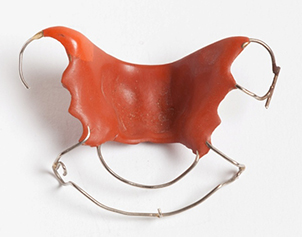Early removable appliances
The first removable appliance was used by the German dentist, Friedrich Christoph Kneisel on a prognathic patient in 1836. Very early appliances were made out of ivory with hickory wood pegs often used for tooth movement. Precious metals were also commonly used. Vulcanite, a vulcanised rubber, was introduced in the 1850s and made removable appliances more accessible. The introduction of acrylic in the 1930s increased accessibility even more. The museum collection contains some examples of these early appliances.

Ivory orthodontic plate on upper model with holes for pegs for tooth movement.

Vulcanite upper appliance with palatal and labial arches and simple clasps

Modified Badcock appliance with vulcanite bite plate with two central screws and depressor spurs.